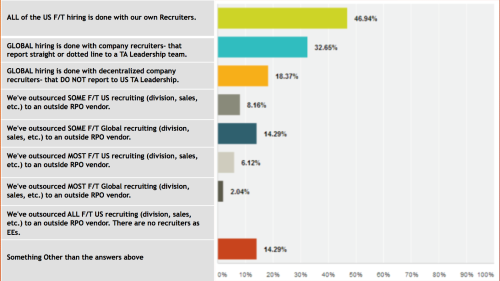A recent report from CareerXroads, “Sources of Hire 2014: Filling the Gaps” by Gerry Crispin and Mark Mehler, aims to continue the conversation about the data collection issues, source of hire trends, and challenges related to the recruiting supply chain. The report looks at 50 large firms (all with well-known brands) that filled 507,425 openings in the U.S. last year. This was the work of ~6000 recruiters and sourcers (80+ openings filled by each).
- 4% of these companies had fewer than 1,500 full time U.S employees,
- 8% had between 1,005-5,000 employees
- 18% between 5,001-10,000 employees
- 28% between 10,001-25,000 employees
- 10% between 25,001-50,000 employees
- 14% between 50,001-100,000 employees
- 8% between 10,001-200,000 employees
- 10% had more than 200,000 employees
An initial trend observed was that at 40% of these firms the Talent Acquisition function does not match the full ‘Scope’ of full time hiring. While 62.5% of the surveyed firms’ Talent Acquisition functions agree that they “touch or know about EVERY F/T hire or move,” 8.3% don’t hire for union positions, 18.8% don’t hire hourly workers in their manufacturing facilities, 16.7% don’t hire hourly workers for store level, 14.6% don’t hire for every function (i.e. field sales), 10.4% don’t hire for every location, and 8.3% don’t hire for every division.
Additionally, when asked about employees that are not full time (i.e. contract or contingent workers) firms noted that 1 in 6 employees (or 17.7%, weighted average) were contingent and generally not tracked by talent acquisition or talent management. We’ve seen the hiring and retention of contract workers increasing at many organizations, and while whether this is a positive or negative trend can really only be decided by how a company manages its contingent workers, CareerXroads does pose the question: “Do we even know where purchasing ‘sourced’ these ‘not-employees’? How can employers build strategy without oversight of ALL those who work at the firm?” If you’re at an organization that hires many contingent workers, it’s a good question to ask.
In terms of who is recruiting talent for organizations, recruitment process outsourcing seems to be a popular choice for organizations today. Over 50% of the firms surveyed in CareerXroad’s report stated that they use RPO services in some form:
Are companies hiring globally? 80% of the firms surveyed report that they do hire globally, though only 41% state that they have access to source of hire information that would allow them to benchmark by country.
The #1 source of hire for organizations, though, is through internal promotion and movement. 41.9% of all openings are filled this way. Of the firms surveyed in 2013, 191,425 openings were filled internally. Interns are another interesting source of hire. Surprisingly, CareerXroads data highlight that organizations aren’t exactly seeing a strong ROI in this area. Only 32% of all interns organizations would want to hire after their internships accept positions. Other hiring trends that are continuing include incorporating sourcing (60.5% of organizations stated that they do have a separate full time sourcing group) and social media. With the rise of social media (and LinkedIn specifically) use of resume databases has declined. When looking at LinkedIn’s impact by sources of hire, it is perceived as a vital sourcing tool:
Like the title of their report, CareerXroads offers some good data here to help “fill the gaps.” Keep this in mind when considering you organization’s approach to talent acquisition, talent management, and sources of hire.









